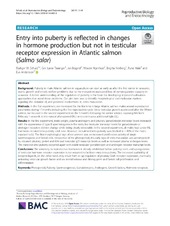| dc.contributor.author | Schulz, Rüdiger W. | |
| dc.contributor.author | Taranger, Geir Lasse | |
| dc.contributor.author | Bogerd, Jan | |
| dc.contributor.author | Nijenhuis, Wouter | |
| dc.contributor.author | Norberg, Birgitta | |
| dc.contributor.author | Male, Rune | |
| dc.contributor.author | Andersson, Eva | |
| dc.date.accessioned | 2020-01-02T13:21:12Z | |
| dc.date.available | 2020-01-02T13:21:12Z | |
| dc.date.issued | 2019-06-21 | |
| dc.Published | Schulz RW, Taranger GL, Bogerd J, Nijenhuis W, Norberg B, Male R, Andersson E. Entry into puberty is reflected in changes in hormone production but not in testicular receptor expression in Atlantic salmon (Salmo salar). Reproductive Biology and Endocrinology. 2019;17:48 | eng |
| dc.identifier.issn | 1477-7827 | en_US |
| dc.identifier.uri | http://hdl.handle.net/1956/21248 | |
| dc.description.abstract | Background Puberty in male Atlantic salmon in aquaculture can start as early as after the first winter in seawater, stunts growth and entails welfare problems due to the maturation-associated loss of osmoregulation capacity in seawater. A better understanding of the regulation of puberty is the basis for developing improved cultivation approaches that avoid these problems. Our aim here was to identify morphological and molecular markers signaling the initiation of, and potential involvement in, testis maturation. Methods In the first experiment, we monitored for the first time in large Atlantic salmon males several reproductive parameters during 17 months including the first reproductive cycle. Since testicular growth accelerated after the Winter solstice, we focused in the second experiment on the 5 months following the winter solstice, exposing fish from February 1 onwards to the natural photoperiod (NL) or to continuous additional light (LL). Results In the first experiment, testis weight, plasma androgens and pituitary gonadotropin transcript levels increased with the appearance of type B spermatogonia in the testis, but testicular transcript levels for gonadotropin or androgen receptors did not change while being clearly detectable. In the second experiment, all males kept under NL had been recruited into puberty until June. However, recruitment into puberty was blocked in ~ 40% of the males exposed to LL. The first morphological sign of recruitment was an increased proliferation activity of single spermatogonia and Sertoli cells. Irrespective of the photoperiod, this early sign of testis maturation was accompanied by elevated pituitary gnrhr4 and fshb and testicular igf3 transcript levels as well as increased plasma androgen levels. The transition into puberty occurred again with stable testicular gonadotropin and androgen receptor transcript levels. Conclusions The sensitivity to reproductive hormones is already established before puberty starts and up-regulation of testicular hormone receptor expression is not required to facilitate entry into puberty. The increased availability of receptor ligands, on the other hand, may result from an up-regulation of pituitary Gnrh receptor expression, eventually activating testicular growth factor and sex steroid release and driving germ and Sertoli cell proliferation and differentiation. | en_US |
| dc.language.iso | eng | eng |
| dc.publisher | BMC | en_US |
| dc.rights | Attribution CC BY | eng |
| dc.rights.uri | http://creativecommons.org/licenses/by/4.0 | eng |
| dc.subject | Photoperiod | eng |
| dc.subject | Puberty | eng |
| dc.subject | Spermatogenesis | eng |
| dc.subject | Gonadotropins | eng |
| dc.subject | Androgens | eng |
| dc.subject | Growth factors | eng |
| dc.subject | Hormone receptors | eng |
| dc.title | Entry into puberty is reflected in changes in hormone production but not in testicular receptor expression in Atlantic salmon (Salmo salar) | en_US |
| dc.type | Peer reviewed | |
| dc.type | Journal article | |
| dc.date.updated | 2019-09-06T06:33:59Z | |
| dc.description.version | publishedVersion | en_US |
| dc.rights.holder | Copyright 2019 The Author(s) | en_US |
| dc.identifier.doi | https://doi.org/10.1186/s12958-019-0493-8 | |
| dc.identifier.cristin | 1721146 | |
| dc.source.journal | Reproductive Biology and Endocrinology | |

